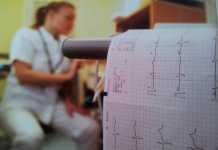Indianapolis, Ind. � September 2005 - Guidant Corporation announced that it is informing physicians about two separate failure modes, each occurring at a low rate, being monitored within the INSIGNIA� and NEXUS� families of Guidant implantable pacemakers. Physicians should use this information to decide how best to treat their patients.
These failure modes may result in one or more of the following device behaviors:
- Intermittent or permanent loss of pacing output without warning
- Intermittent or permanent loss of telemetry
- Appearance of a reset warning message upon interrogation
The clinical behaviors associated with these failure modes can result in serious health complications. There have been no reported deaths resulting from these failure modes. Loss of pacing output associated with these failure modes has resulted in syncope as well as presyncope requiring hospitalization.
For the first failure mode, as of September 6, 2005, Guidant has confirmed thirty-six (36) failures out of 49,500 implanted devices (0.073%). Seven (7) of these devices exhibited no output during the implant procedures. For devices successfully implanted, the majority of failures occurred early in life, with a mean implant time of seven (7) months. This failure mode demonstrates a failure rate that decreases with implant time. No failures have been reported beyond twenty-two (22) months of service. Guidant has received three (3) reports of syncope, and six (6) reports of bradycardia or heart block associated with this failure mode which required emergency hospitalization. One device was determined to have failed briefly and resumed functioning with no indication to the physician detectable during routine follow-up.
Guidant's modeling based on field experience and statistical analysis, predicts the failure rate for the active device population of 41,000 to be between 0.017% to 0.037% over the remaining device lifetime, or approximately seven (7) to fifteen (15) additional failures. An estimated 24,000 are active in the United States. Root cause has been identified as foreign material within a crystal timing component. The supplier of the crystal timing component used in this subset has eliminated foreign material within the crystal chamber, and no such failures have been observed in any devices shipped after March 12, 2004.
Continue Reading Below ↓↓↓
The United States Food and Drug Administration (FDA) has determined this communication action to be a recall. Physicians should consider the projected low and declining failure rate in addition to the unique needs of individual patients in their medical decisions regarding patient management. Guidant recommends normal device monitoring, as per device labeling. As always, Guidant advises patients to seek medical attention immediately if they experience syncope or lightheadedness.
As of September 6, 2005, sixteen (16) failures associated with a second failure mode have been confirmed out of 341,000 INSIGNIA and NEXUS devices distributed worldwide (0.0047%). For all sixteen devices, a "no output" condition was exhibited at the implant procedure or pre-implant testing. Guidant has received one (1) report of a pacemaker-dependent patient experiencing syncope and resuscitated cardiac arrest that occurred in association with loss of pacing output during an elective pulse generator replacement procedure. Root cause analysis is ongoing; a specific root cause for this observation has not yet been determined. An estimated 145,000 of these devices are active in the United States.
The United States Food and Drug Administration (FDA) may determine this communication action to be a recall. Guidant recommends verifying pacemaker operation in the packaging prior to the implant procedure. Devices exhibiting intermittent or permanent loss of output and/or telemetry should not be implanted. Physicians should consider both the very low occurrence rate and that no failures have been observed after successful confirmation of pacing at implant, in addition to the unique needs of individual patients, in their medical decisions regarding patient management.
The following model numbers are affected by this communication*:
- INSIGNIA Entra SSI, models 0484 and 0485
- INSIGNIA Entra DDD, models 0985 and 0986
- INSIGNIA Entra SR, models 1195 and 1198
- INSIGNIA Entra DR, models 1294, 1295, and 1296
- INSIGNIA Ultra SR, model 1190
- INSIGNIA Ultra DR, models 1290 and 1291
- INSIGNIA Plus SR, model 1194
- INSIGNIA Plus DR, models 1297 and 1298
- INSIGNIA AVT SSI, model 482
- INSIGNIA AVT VDD, model 882
- INSIGNIA AVT DDD, model 982
- INSIGNIA AVT SR, model 1192
- INSIGNIA AVT DR, model 1292
- NEXUS Entra SSI, models 1325 and 1326
- NEXUS Entra DDD, models 1425 and 1426
- NEXUS Entra SR, models 1395 and 1398
- NEXUS Entra DR, models 1466, 1494, and 1495
- NEXUS Ultra SR, model 1390
- NEXUS Ultra DR, models 1490 and 1491
- NEXUS Plus SR, model 1394
- NEXUS Plus DR, models 1467 and 1468
- NEXUS AVT SSI, model 1328
- NEXUS AVT VDD, model 1428
- NEXUS AVT DDD, model 1432
- NEXUS AVT SR, model 1392
- NEXUS AVT DR, model 1492
* Not all models are available in all geographies.
Additional information about this potential issue is available for physicians and patients at 1-866-GUIDANT (1-866-484-3268) (24/7) and www.guidant.com/physician_communications.
This release includes forward-looking statements concerning the course of developments with respect to the affected products. These statements are based on assumptions about many important factors, including continuing developments with respect to adverse event rates, regulatory agency actions, and other factors identified on Exhibit 99 to the company's most recent 10-Q. Actual results may differ materially. The company does not undertake to update its forward-looking statements.
Source: Guidant Corporation









